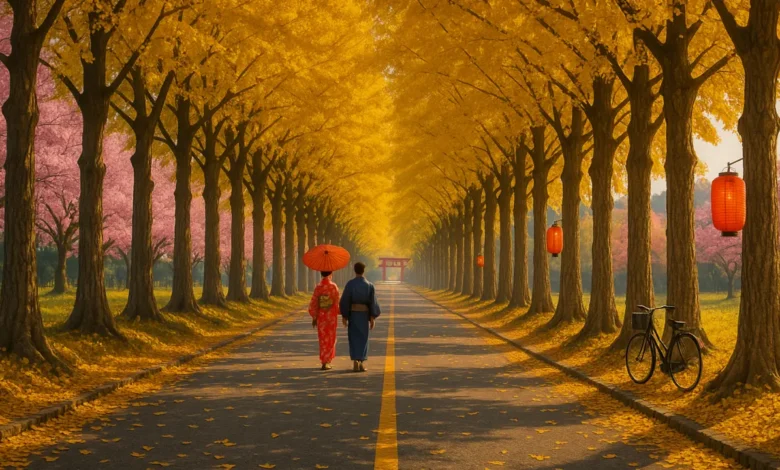Yellow Springs Road Japan: Discover the Golden Pathways of Nature’s Seasons

Japan is renowned worldwide for its breathtaking landscapes, seasonal beauty, and harmonious blend of tradition and nature. Among its most photogenic and lesser-known gems is the enchanting Yellow Springs Road Japan. This destination, often described as a dreamlike golden tunnel, attracts photographers, travelers, and nature enthusiasts who wish to immerse themselves in a road draped in blossoms and glowing leaves. In this guide, we’ll explore everything about Yellow Springs Road Japan—its locations, seasonal highlights, best travel tips, photography advice, and how you can plan the perfect visit.
What is Yellow Springs Road Japan?
Yellow Springs Road in Japan is not just a single destination, but rather a name used to describe scenic stretches of road in Japan where trees bloom spectacularly in the spring or turn golden in the autumn. The most famous versions are:
- The Ginkgo Tree Road (Tokyo/Chiba Prefecture) – A golden canopy of over 140 ginkgo trees that turns into a glowing yellow tunnel from late October to December.
- The Hirokawa Trail (Izu/Hirokawa Region) – A countryside road lined with cherry blossoms in spring and fiery foliage in autumn, often associated with traditional hanami picnics and cultural festivals.
Both variations embody the beauty of Japanese seasons and represent how roads are transformed into living art by nature.
Seasonal Highlights of Yellow Springs Road Japan
The real charm of Yellow Springs Road Japan lies in its dramatic seasonal changes. Visitors can plan their trips according to whether they want to see cherry blossoms, golden leaves, or vibrant autumn scenery.
Spring: The Season of Blossoms
In Hirokawa and other countryside variations of Yellow Springs Road Japan, spring transforms the road into a floral paradise.
- Cherry Blossoms (Sakura) bloom from late March to early April, creating a pink and white tunnel.
- Families gather under the trees for hanami picnics, enjoying food, drinks, and socializing with one another.
- The atmosphere is festive, filled with lanterns, street vendors, and cultural performances.
Autumn: The Golden Transformation
The Tokyo/Chiba ginkgo-lined Yellow Springs Road is best known for its autumn magic.
- From late October to early December, the ginkgo leaves turn a striking golden yellow.
- The canopy creates a surreal tunnel effect, ideal for photography and peaceful walks.
- In Hirokawa, autumn also means fiery red maples and amber foliage, making the countryside equally stunning.
Summer and Winter: Lesser-Known Seasons
- Summer: While not as famous, Yellow Springs Road is lush and green, with occasional sunflower fields nearby (in Hirokawa).
- Winter: The trees lose their leaves, but the stillness offers a quiet, spiritual atmosphere for reflective walks.
Activities to Enjoy on Yellow Springs Road Japan
Whether you’re in Tokyo’s ginkgo-lined version or exploring Hirokawa’s countryside path, there are plenty of things to do:
Photography Haven
Yellow Springs Road Japan is a dream location for photographers.
- Golden Hour Shots: Early morning or evening gives soft, glowing light.
- Framing with Leading Lines: Use the road as a central composition guide.
- Seasonal Props: Adding parasols, kimonos, or bicycles to photos brings cultural charm.
Hanami & Picnicking
- In spring, families and tourists gather under the blossoms for hanami.
- Local vendors often sell street food like takoyaki, yakitori, and sakura mochi.
Nature Walks & Hiking
- Hirokawa’s Yellow Springs Road connects to countryside trails perfect for light hikes.
- Some trails lead to viewpoints overlooking valleys and traditional villages.
Cultural Immersion
- Hirokawa often hosts seasonal festivals, tea ceremonies, and traditional performances.
- Tokyo’s ginkgo route may be less cultural, but its proximity to the city means access to museums, gardens, and historical landmarks.
Where is Yellow Springs Road Japan Located?
Tokyo/Chiba Ginkgo Tree Road
- Located on the outskirts of Tokyo in Chiba Prefecture.
- Easily accessible by train or bus from central Tokyo.
- Popular with city dwellers seeking a quick autumn escape.
Hirokawa/Izu Countryside Trail
- Found in Hirokawa, a rural area often associated with the Izu Peninsula.
- Surrounded by hills, rice fields, and traditional Japanese homes.
- Requires more travel time but offers an authentic countryside experience.
Best Time to Visit Yellow Springs Road Japan
Timing your trip is crucial for the best experience.
| Season | Highlight | Best Time to Visit |
|---|---|---|
| Spring | Cherry Blossoms (Hirokawa) | Late March – Early April |
| Summer | Lush Greenery, Sunflowers | July – August |
| Autumn | Golden Ginkgo (Tokyo/Chiba), Red Maples (Hirokawa) | Late October – Early December |
| Winter | Quiet Walks, Bare Trees | December – February |
Travel Tips for Visiting Yellow Springs Road Japan
- Arrive Early – These roads get crowded during peak blossom or foliage season. Early mornings offer serenity and provide better opportunities for photography.
- Wear Comfortable Shoes – Both routes require walking, and Hirokawa includes light hiking.
- Respect Nature – Stay on marked paths, avoid picking flowers or leaves, and carry waste with you.
- Check the Forecast – Blossoms and foliage can cause fluctuations in the weather from one year to the next.
- Bring Photography Gear – Tripods, wide-angle lenses, and even drones (if permitted) can help capture the scenery.
Photography Tips for Yellow Springs Road Japan
To capture the whole magic of Yellow Springs Road Japan, here are some professional tips:
- Use Wide-Angle Lenses to showcase the whole canopy and road.
- Golden Hour Lighting enhances the colors of blossoms and leaves, making them appear more vibrant.
- Include People or props, such as kimonos, bicycles, or umbrellas, to establish scale and enhance storytelling.
- Experiment with Angles: Try low shots looking up at the canopy or use aerial perspectives, such as drone photography (if allowed).
Accommodation Near Yellow Springs Road Japan
For Tokyo/Chiba (Ginkgo Road):
- Tokyo Hotels: Stay in Shinjuku, Shibuya, or Asakusa for easy access.
- Chiba Guesthouses: Budget travelers can enjoy traditional ryokan stays near the countryside.
For Hirokawa/Izu (Countryside Trail):
- Ryokan Inns: Experience tatami rooms, futons, and hot springs (onsen).
- Minshuku (Family Inns): Affordable stays with home-cooked Japanese meals.
- Luxury Resorts: Some located near the Izu Peninsula provide breathtaking vistas of the sea and mountains.
Why Yellow Springs Road Japan is Special
Unlike heavily commercialized tourist spots, Yellow Springs Road Japan still retains a peaceful, authentic charm.
- It provides a harmonious blend of cultural tradition and natural splendor.
- Travelers experience Japan’s seasonal rhythm, from cherry blossoms to autumn leaves.
- It’s an ideal escape for photographers, couples, families, and solo travelers seeking tranquility.
How to Get There
From Tokyo (to Chiba Ginkgo Road):
- By Train: JR Sobu Line to Chiba Station, then bus/taxi to the road.
- By Car: 1–1.5 hours from central Tokyo.
From Tokyo (to Hirokawa/Izu Road):
- By Train: Take the Shinkansen to Mishima Station, then local trains/buses.
- By Car: About 2–3 hours’ drive, depending on traffic.
Frequently Asked Questions About Yellow Springs Road Japan
Is Yellow Springs Road Japan the same as Icho Namiki in Tokyo?
No. Icho Namiki near Meiji Jingu Gaien is another ginkgo-lined avenue in Tokyo. Yellow Springs Road Japan refers to separate scenic roads in Chiba and Hirokawa.
How long should I spend there?
Chiba (Ginkgo Road): 2–3 hours is enough.
Hirokawa (Countryside Road): A half or full day, especially if you hike and explore nearby villages.
Is it free to visit?
Yes. Both versions of Yellow Springs Road Japan are public spaces.
Conclusion: The Enchantment of Yellow Springs Road Japan
Visiting Yellow Springs Road Japan is like stepping into a painting where nature takes center stage. Whether you’re marveling at the golden ginkgo tunnel in Chiba or enjoying hanami under Hirokawa’s cherry blossoms, these roads embody Japan’s timeless beauty, especially during its seasonal splendor.
You May Also Read: TheLowDownUnder Travel: Your Gateway to Soulful and Sustainable Exploration




